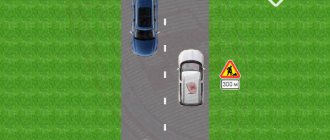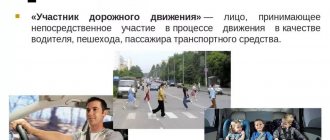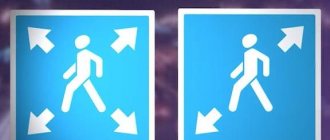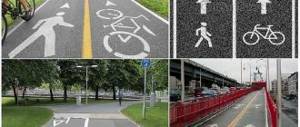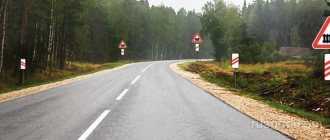Markings in traffic rules
Painted elements on the road are very common and come in different forms. They look different, and each option is designed to regulate movement or limit it in some situation.
However, the traffic rules indicate only 2 types of markings:
- Horizontal. It is used directly on the road and is represented by lines, arrows, and inscriptions. This type is necessary to establish the order of movement, and sometimes restrictions;
- Vertical. It is usually used on poles and other structures on the road. Such markings are intended to protect drivers from possible dangers, since some objects are not visible at night, and with its help the dimensions become clear. Most often, this look looks like an alternating combination of reflective black and white stripes.
It happens that white stripes are applied, and on top of them there are yellow stripes and their directions differ. In this case, you must continue driving based on the direction of the yellow markings, even if they have a different meaning than white stripes.
Yellow road signs are temporary and are usually found in areas where repairs are being carried out and in other situations. After a certain period they are removed.
When can you drive in a dedicated lane?
Listed above are vehicles that can use the bus lane along with shuttle buses. In other words, drive along it.
However, all other cars can enter the bus lane in some cases. Paragraph 18.2 of the traffic rules:
If this lane is separated from the rest of the roadway by a broken marking line, then when turning, vehicles must change lanes to it. It is also permitted in such places to enter this lane when entering the road and for boarding and disembarking passengers at the right edge of the roadway, provided that this does not interfere with route vehicles.
Right turn
The driver must turn right from a dedicated lane , if such a lane is separated by a broken marking line (left side of the picture):
Horizontal marking
Horizontal road markings have more variations than vertical ones, so we will consider them first.
For convenience, each option is numbered. 1.1 – this view is presented in solid form. Usually it separates traffic flows moving opposite each other. It is also sometimes drawn to indicate boundaries. According to traffic regulations, you cannot drive onto it.
1.2.1 is also a solid line, but it is drawn at the edge of a certain area to designate it. It is allowed to drive over it only where you can park your car or stop for a short time.
1.2.2. – applying road markings with a broken line. It is usually located on roads with 2 lanes to separate traffic. You can run into it, and therefore overtake other cars, but only after making sure that the maneuver is safe.
1.3 – represented by 2 solid ones and is usually needed to separate the flow of cars that are moving in the opposite direction. It occurs frequently, but you cannot travel beyond it.
1.4 is a yellow line, which is most often applied on the top of the curb or at the edge of the road. It indicates places where you cannot stop by car, even for a short period of time.
1.5 – markings represented by dotted lines. It is usually used to separate lanes in passing directions, as well as to indicate flows moving in different directions, if there are no more than 3 lanes on the road.
1.6 – a dotted line in which each stroke is longer than the distance from it to the other strip. It warns drivers that they will soon approach a solid road that they must not drive over.
1.7 – stripe with short strokes. It is drawn at intersections and within them.
1.8 – dotted line with increased width. It indicates for drivers the distance between the acceleration lane and the main lane.
1.9 – double dotted line, used on terrain with reverse traffic.
1.10 – intermittent yellow. Necessary to indicate areas where the car cannot be parked for a long period.
1.11 – double line – one is solid and the other is broken. Indicates that on a certain road you can change lanes or make any maneuver only on one side of the road.
1.12 – markings that are usually used in front of a traffic light or in front of a STOP sign. It indicates the boundaries for the driver where he should stop.
1.13 – markings in the form of identical triangles. It is located where you need to stop and let cars from other directions pass.
1.14.1 and 1.14.2 – pedestrian crossing. The only difference between these elements is that in the second case the direction is indicated by arrows.
1.15 – necessary to mark areas where a path for cyclists is located on a road for cars.
1.16.1, 1.16.2 and 1.16.3 - usually looks like a triangle. This element is applied on “islands”.
1.17 – intended to indicate stops.
1.18 – represented by arrows and informs where you can move on a certain lane.
1.19 – looks like a rounded arrow and is drawn before the road narrows.
1.20 – looks like one triangle. She informs that soon it will be necessary to let other cars through.
1.21 – inscription “STOP”. It is used before a traffic light or intersection and informs drivers that they will soon need to stop.
1.22 – markings with symbols to indicate the road.
1.23.1-1.23.3 – indicates the boundaries of lanes for certain types of transport.
1.24.1- 1.24.5 – duplicate markings.
Not long ago, another road marking under number 1.26 was added to the traffic rules and included in GOST for correct application. It is yellow in color and is used at intersections. This element of the roadway designates an area where driving is prohibited if there is a traffic jam ahead. The exception is if the entry is made for a U-turn or turn.
Can buses leave a dedicated lane?
So, the first thing I want to focus on in this article is the movement of public transport on a road with a dedicated lane. I would like to immediately note the fact that bus drivers are not required to move in the bus lane .
The rules prohibit the movement of all vehicles on a dedicated lane (except for a few exceptions, which will be discussed below), but they do not in any way restrict the movement of buses and trolleybuses.
For example, if a dedicated lane is separated from the rest of the road by a broken marking line, and in a given direction there is at least one more lane intended for all road users, then buses and trolleybuses can, if desired, change lanes between the dedicated and regular lanes any number of times.
So, if there is a bus lane on the road, then public transport has more room to maneuver than all other cars.
Vertical marking
When driving, vertical objects are usually visible as well. They become more pronounced due to vertical markings. It is also numbered.
So, the vertical marking is presented:
2.1.1 – 2.1.3 – usually applied to poles and other high vertical objects on the road.
2.2 – used on the lowest edge of structures if they are located above the road.
2.3 – necessary to designate rounded objects. They are usually located in the middle of the road to separate traffic going in different directions.
2.4 - also used on small rounded posts, but to determine the direction.
2.5 - often found on rounded bridges, as well as when driving in the mountains and other dangerous areas.
2.6 – used on fences that are installed on straight sections of roads.
2.7 – applied on curbs to make them easier to see.
Of course, there are fewer vertical markings, but their role is very important, especially at night. Thanks to it, many objects become better visible. So that it does not harm motorists, but, on the contrary, is useful, when applying it, GOST Road markings must be observed.
Fines for driving in public transport lanes
| Direction | Region | Reason for leaving | Punishment |
| incidental | Moscow or St. Petersburg | — | 3,000 rubles |
| incidental | other regions | — | 1,500 rubles |
| counter | — | avoiding obstacles | 1,000 - 1,500 rubles |
| counter | — | other reasons | 5,000 rubles or deprivation of rights for 4 - 6 months; repeated: deprivation of rights for 1 year or 5,000 rubles |
More detailed information on fines on a dedicated lane is provided in the article:
In order not to get confused by fines for various violations of the rules, I recommend downloading and printing the current traffic police fines table and putting it in your car.
Finally, here is a video where you can see a road with two dedicated lanes for public transport:
Automatic violation detection systems will be installed on similar sections of roads in 2021 and 2021. So punishment for violating drivers is inevitable. By the way, if you suspect that you might have accidentally violated the rules while on camera, you can first find out about traffic police fines online and then pay them.
solid line
Very often, when driving through a certain area, you can see a solid one. In the driving school, starting from the first lessons, they indicate that such a road element cannot be crossed. Even a normal collision with this line can result in a fine. Traffic police officers are well aware of this and therefore often patrol sections of roads where a solid line is drawn.
Solid is usually used in 4 situations:
- to separate flows of different directions in areas with 2 lanes;
- on roads with sharp turns, where oncoming cars become invisible;
- in urban conditions before an intersection or other dangerous area;
- to designate minibus lanes.
This type is also applied in the parking lot to make it easier for drivers to park their car.
In some cases, a solid road indicates an area where you cannot enter. This is usually done on the highway, outside the city. On the roads, and especially in the city, there are also double solid lines. It is used in other situations, but its essence is the same.
You cannot cross or run into it. This should not be done, not even to avoid a fine, but also for personal safety. As you can see, a solid one is usually applied in dangerous areas so that there are no collisions with it.
Who can ride in the bus lane?
Paragraph 18.2 of the traffic rules contains a list of vehicles that can enter the dedicated lane:
- Route vehicles (buses, trolleybuses, minibuses).
- School buses.
- Passenger taxis.
- Buses heavier than 5 tons, which are included in special lists approved by the executive authorities of Moscow, St. Petersburg or Sevastopol.
- Cyclists.
Please note that school buses, taxis, scheduled buses and cyclists may not always use the bus lane. Consider the following situation:
Look at the right side of the picture. A sign 3.1 (brick) is installed above the dedicated lane , prohibiting entry into this lane. This sign does not apply to fixed-route vehicles, but it prohibits traffic in the designated lane for all others.
Therefore, if you are riding, for example, a bicycle, then before entering the dedicated lane, make sure that additional signs do not prohibit this.
In addition, the list of exceptions does not include :
- Car sharing cars (they are neither taxis nor route vehicles).
- Motorcycles.
- Mopeds and scooters.
- Buses for transporting children that are not school buses.
Signs on the road
On some road sections, drivers may see the signs shown. For example, you can drive along the roadway, and there is a “stop” sign on it. This sign tells drivers that they are approaching the place where the 2.5 sign is located.
Also on the road there may be inscriptions like A-01 and many others. They talk about the number of the road. But the lane designation with the inscription “A”, which is often found in large cities, designates a lane for route vehicles.
The image of a man indicates the pedestrian part of the road, which can be used not only by pedestrians, but also by cyclists.
Features of movement
Markings numbered 1.22, 1.5-1.8 can be crossed in any direction. This is important to take into account when studying traffic rules, since the markings on the road are always indicated in the photo, they are taken into account in tickets.
Marking 1.9 can be crossed if there are no reversible traffic lights or when they are completely turned off, but only if you are located to the right of the driver. When the traffic light is on, the line can be crossed from any side. As soon as the traffic lights turn off, you must immediately change lanes beyond the reverse traffic markings.
Double
A common occurrence is duplication of prohibitory and warning signs. For example, outside a populated area, the driver saw a “50” sign on the road.
In places where the speed of traffic is regulated by artificial unevenness, not only signs are posted, but also special road markings are applied in the form of white squares arranged in several rows in a checkerboard pattern.
Just drunk
No, this is not even Through the Looking Glass, and not the work of Bender with his accomplice Vorobyaninov on the ship, as a result of which the ugliest welcome poster was revealed to the world, but simply the work of the average Avtodor drunk.
Of course, one can assume that some group from the kindergarten stole paints from the markers, deciding to paint the canvas like a giant coloring book, but knowing the harsh realities, the illusory nature of such a fantasy becomes obvious.
